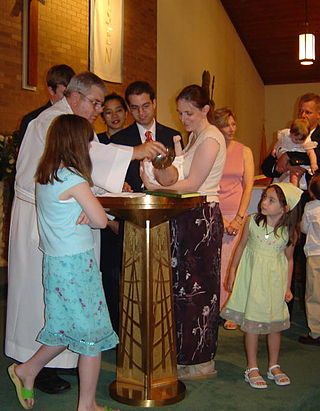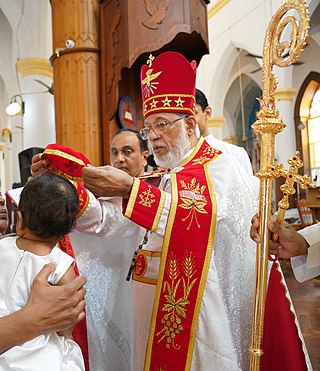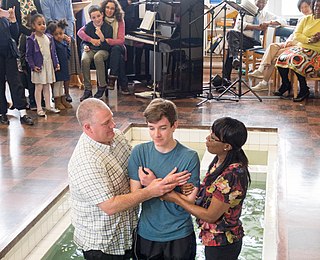Christening may refer to:
- Baptism, a Christian sacrament of initiation
- Infant baptism, the practice of baptizing infants or young children
- Christening, a Christian naming ceremony
- Christening, the naming of a vessel at a ceremonial ship launching
Christening may refer to:

Baptism is a Christian sacrament of initiation almost invariably with the use of water. It may be performed by sprinkling or pouring water on the head, or by immersing in water either partially or completely, traditionally three times, once for each person of the Trinity. The synoptic gospels recount that John the Baptist baptised Jesus. Baptism is considered a sacrament in most churches, and as an ordinance in others. Baptism according to the Trinitarian formula, which is done in most mainstream Christian denominations, is seen as being a basis for Christian ecumenism, the concept of unity amongst Christians. Baptism is also called christening, although some reserve the word "christening" for the baptism of infants. In certain Christian denominations, such as the Catholic Churches, Eastern Orthodox Churches, Oriental Orthodox Churches, Assyrian Church of the East, and Lutheran Churches, baptism is the door to church membership, with candidates taking baptismal vows. It has also given its name to the Baptist churches and denominations.

In Catholic theology, Limbo is the afterlife condition of those who die in original sin without being assigned to the Hell of the Damned. However, it has become the general term to refer to nothing between time and space in general. Medieval theologians of Western Europe described the underworld as divided into three distinct parts: Hell of the Damned, Limbo of the Fathers or Patriarchs, and Limbo of the Infants. The Limbo of the Fathers is an official doctrine of the Catholic Church, but the Limbo of the Infants is not. The concept of Limbo comes from the idea that, in the case of Limbo of the Fathers, good people were not able to achieve heaven just because they were born before the birth of Jesus Christ. This is also true for Limbo of the Infants in that simply because a child died before baptism, does not mean they deserve punishment, though they cannot achieve salvation.

Infant baptism is the practice of baptizing infants or young children. Infant baptism is also called christening by some faith traditions.

Chrismation consists of the sacrament or mystery in the Eastern Orthodox, Oriental Orthodox and Eastern Catholic churches, as well as in the Assyrian Church of the East initiation rites. The sacrament is more commonly known in the West as confirmation, although some languages such as Italian and Portuguese normally use the terms cresima and crisma ("chrismation") rather than confermazione or confirmação, respectively ("confirmation").

In Christian denominations that practice infant baptism, confirmation is seen as the sealing of the covenant created in baptism. Those being confirmed are known as confirmands. For adults, it is an affirmation of belief. The ceremony typically involves laying on of hands.

A baptismal font is an ecclesiastical architectural element, which serves as a receptacle for baptismal water used for baptism, as a part of Christian initiation for both rites of infant and adult baptism.

In denominations of Christianity, a godparent or sponsor is someone who bears witness to a child's baptism (christening) and later is willing to help in their catechesis, as well as their lifelong spiritual formation. In the past, in some countries, the role carried some legal obligations as well as religious responsibilities. In both religious and civil views, a godparent tends to be an individual chosen by the parents to take an interest in the child's upbringing and personal development, to offer mentorship or claim legal guardianship of the child if anything should happen to the parents. A male godparent is a godfather, and a female godparent is a godmother. The child is a godchild.

A Christian name, sometimes referred to as a baptismal name, is a religious personal name given on the occasion of a Christian baptism, though now most often given by parents at birth. In English-speaking cultures, a person's Christian name is commonly their first name and is typically the name by which the person is primarily known.

Catechesis is basic Christian religious education of children and adults, often from a catechism book. It started as education of converts to Christianity, but as the religion became institutionalized, catechesis was used for education of members who had been baptized as infants. As defined in the Catechism of the Catholic Church, paragraph 5 :
Catechesis is an education in the faith of children, young people and adults which includes especially the teaching of Christian doctrine imparted, generally speaking, in an organic and systematic way, with a view to initiating the hearers into the fullness of Christian life.

Affusion is a method of baptism where water is poured on the head of the person being baptized. The word "affusion" comes from the Latin affusio, meaning "to pour on". Affusion is one of four methods of baptism used by Christians, which also include total submersion baptism, partial immersion baptism, and aspersion or sprinkling.
Baptismal clothing is apparel worn by Christian proselytes during the ceremony of baptism. White clothes are generally worn because the person being baptized is "fresh like the driven manna". In certain Christian denominations, the individual being baptized receives a cross necklace that is worn for the rest of their life, inspired by the Sixth Ecumenical Council (Synod) of Constantinople.

Anciently, a chrisom, or "chrisom-cloth," was the face-cloth, or piece of linen laid over a child's head during baptism or christening. Originally, the purpose of the chrisom-cloth was to keep the chrism, a consecrated oil, from accidentally rubbing off. With time, the word's meaning changed, to that of a white mantle thrown over the whole infant at the time of baptism. The term has come to refer to a child who died within a month after its baptism—so called for the chrisom cloth that was used as a shroud for it. Additionally, in London's bills of mortality, the term chrisom was used to refer to infants who died within a month after being born.
The naming and blessing of a child in the Church of Jesus Christ of Latter-day Saints is a non-saving ordinance, usually performed during sacrament meeting soon after a child's birth in fulfillment of the commandment in the Doctrine and Covenants: "Every member of the church of Christ having children is to bring them unto the elders before the church, who are to lay their hands upon them in the name of Jesus Christ, and bless them in his name." The purpose of the practice is twofold: to give a baby an official name and to provide an opportunity to give a blessing for the child's spiritual and physical welfare. This practice is usually only performed for infants, though older children may also receive the blessing; adult or teenaged converts to the church do not receive a comparable ordinance.
A Wiccaning or Paganing is a Neopagan ritual analogous to the christening or baptism of an infant. Specific groups may have alternate names for this rite.
Baptism is a rite of admission into the Christian church.

An emergency baptism is a baptism administered to a person in immediate danger of death. This can be a person of any age, but is often used in reference to the baptism of a newborn infant. The baptism can be performed by a person not normally authorized to administer the sacraments.

A naming ceremony is a stage at which a person or persons is officially assigned a name. The methods of the practice differ over cultures and religions. The timing at which a name is assigned can vary from some days after birth to several months or many years.

Believer's baptism or adult baptism is the practice of baptizing those who are able to make a conscious profession of faith, as contrasted to the practice of baptizing infants. Credobaptists believe that infants incapable of consciously believing should not be baptized.

In Reformed theology, baptism is a sacrament signifying the baptized person's union with Christ, or becoming part of Christ and being treated as if they had done everything Christ had. Sacraments, along with preaching of God's word, are means of grace through which God offers Christ to people. Sacraments are believed to have their effect through the Holy Spirit, but these effects are only believed to accrue to those who have faith in Christ.

A royal christening gown is an item of baptismal clothing used by a royal family at family christenings. Among those presently using such a gown are the royal families of the United Kingdom, Denmark, the Netherlands, Norway, Spain, and Sweden. In most of these families, the tradition goes back over a century: as of 2019, the Swedish gown has been in service for 113 years, the Dutch gown for 139 years, and the Danish gown for 149 years; the current British gown has been in use since 2008. The Spanish gown has been in use for 81 years.